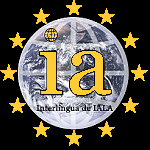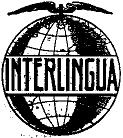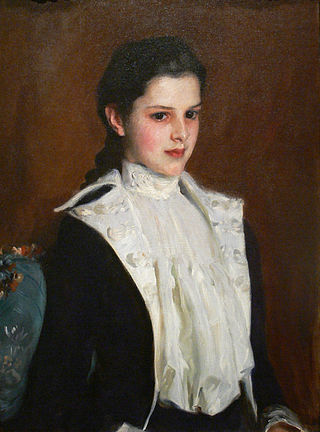
Interlingua is an international auxiliary language (IAL) developed between 1937 and 1951 by the American International Auxiliary Language Association (IALA). It ranks among the most widely used IALs and is the most widely used naturalistic IAL – in other words, those IALs whose vocabulary, grammar, and other characteristics are derived from natural languages, rather than being centrally planned. Interlingua literature maintains that (written) Interlingua is comprehensible to the hundreds of millions of people who speak Romance languages, though it is actively spoken by only a few hundred.
An international auxiliary language is a language meant for communication between people from all different nations, who do not share a common first language. An auxiliary language is primarily a foreign language and often a constructed language. The concept is related to but separate from the idea of a lingua franca that people must use to communicate.

Latino sine flexione, Interlingua de Academia pro Interlingua or Peano's Interlingua, is an international auxiliary language compiled by the Academia pro Interlingua under chairmanship of the Italian mathematician Giuseppe Peano (1858–1932) from 1887 until 1914. It is a simplified version of Latin, and retains its vocabulary. Interlingua-IL was published in the journal Revue de Mathématiques in an article of 1903 entitled De Latino Sine Flexione, Lingua Auxiliare Internationale, which explained the reason for its creation. The article argued that other auxiliary languages were unnecessary, since Latin was already established as the world's international language. The article was written in classical Latin, but it gradually dropped its inflections until there were none.
The Union Mundial pro Interlingua is a global organization that promotes Interlingua, an international auxiliary language (IAL) published in 1951 by the International Auxiliary Language Association (IALA). UMI was founded on July 28, 1955, when the first International Interlingua Congress took place in Tours, France. The UMI collaborates with the national Interlingua organizations and has a hand in publishing dictionaries, grammars and tutorials. It is a non-profit organization that now operates out of Bilthoven, Netherlands.
In linguistic typology, object–verb–subject (OVS) or object–verb–agent (OVA) is a rare permutation of word order. OVS denotes the sequence object–verb–subject in unmarked expressions: Oranges ate Sam, Thorns have roses. The passive voice in English may appear to be in the OVS order, but that is not an accurate description. In an active voice sentence like Sam ate the oranges, the grammatical subject, Sam, is the agent and is acting on the patient, the oranges, which are the object of the verb, ate. In the passive voice, The oranges were eaten by Sam, the order is reversed and so that patient is followed by the verb and then the agent. However, the oranges become the subject of the verb, were eaten, which is modified by the prepositional phrase, by Sam, which expresses the agent, and so the usual subject–verb–(object) order is maintained.
Ido and Interlingua are two constructed languages created in the 20th century, Ido circa 1910 and Interlingua circa 1940. Both have had some measure of success, but Interlingua has enjoyed greater diffusion and acceptance by public and private institutions—it is taught in many high schools and universities, for example. Ido was developed by a small committee from Reformed Esperanto, whereas Interlingua was developed from scratch by an American organization, the IALA.
William Edward Collinson was a British linguist and, from 1914 to 1954, Chair of German at the University of Liverpool. Like Edward Sapir and Otto Jespersen, he collaborated with Alice Vanderbilt Morris to develop the research program of the International Auxiliary Language Association (IALA). From 1936 to 1939, he was Research Director of IALA. Under Collinson's guidance, methods of compiling international word material were tested at Liverpool. In 1939 IALA moved from Liverpool to New York and E. Clark Stillman succeeded Collinson as Research Director. Alexander Gode, editor of the first English-Interlingua dictionary published in 1951, remained in contact with Collinson which had collected much of linguistic material in the University of Liverpool.

Alice Vanderbilt Shepard Morris was a member of the Vanderbilt family. She co-founded the International Auxiliary Language Association (IALA).
The Society for Science and the Public founded its Interlingua Division in 1953. The division made scientific research accessible to a wide audience by translating abstracts and several larger scientific works into Interlingua. The Interlingua Division also made publications of the International Auxiliary Language Association (IALA) available, facilitated contacts among professionals of the same discipline, and opened IALA's extensive library, which included technical and general dictionaries, to the public at no cost. Society for Science and the Public hired Alexander Gode as the division Director; Hugh E. Blair was his assistant.
Jeanne Martinet was a French semiotician and a proprietor of a semiotics school. Her husband was the eminent linguist André Martinet (1908–1999). In 1973, in Paris, Martinet published the book Clefs pour la sémiologie, which has been translated into numerous languages. In 1993, she co-authored, with her husband, the volume Mémoires d'un linguiste.
Interlingua, Instrumento Moderne de Communication International by Ingvar Stenström is a popular Interlingua course. As of 2006, it has been translated into Bulgarian, Danish, French, German, Hungarian, Portuguese, Romanian, Russian, and Swedish; translations into Norwegian and Lithuanian are in final preparation, and five additional languages are expected to follow.
The Brazilian Union for Interlingua is the national Interlingua organization in Brazil. The UBI, founded at the first Brazilian Interlingua Conference in 1990, teaches and promotes Interlingua in South American countries. The UBI arranges annual conferences in Brazil and maintains representation in some Brazilian states.
Interlingua dictionaries are notable for their comprehensiveness; they tend to be larger than for other auxiliary languages. Some of the larger dictionaries are presented here.
Július Tomin was a high school teacher and well-known author from Czechoslovakia. He was persecuted during the Soviet occupation for promoting Interlingua as a second language.
Klavs Neerbek is a Danish author and gymnasium professor. He founded the electronics firm Rap Soft. Bjarner Svejgaard, who had established the Electronic Installation for Calculations at the Geodetic Institute, interested him in text processing during his early years. In 1963, he became a student of mathematics at the Østersøgade Gymnasium, where he helped edit Extra-Posta, the first school magazine in Interlingua.
The Union Danese pro Interlingua, the oldest of the Nordic Interlingua organizations, was established on November 7, 1960 – four years before the Swedish Society for Interlingua. The DIU promotes and provides for the teaching of Interlingua in Denmark and in Nordic countries such as Iceland, which do not yet have official Interlingua representation. It maintains a publishing program and, in collaboration with the Swedish, Norwegian, and Finnish Interlingua organizations, has produced the magazine Actualitates – Interlingua i Norden since 1960.
The Swedish Society for Interlingua, founded January 1, 1964, is an agency that operates in Sweden to publicize Interlingua and encourage its active use. The SSI arranges activities, produces Interlingua publications, and collaborates with the other Nordic Interlingua organizations to publish Actualitates - Interlingua i Norden, a magazine in Interlingua and the Scandinavian languages.
2001 was declared the European Year of Languages by the Council of Europe, the European Union, and UNESCO. In announcing the initiative, the three bodies argued for the importance of language learning for personal development and suggested that lingual competencies are needed to respond to economic, social, and cultural changes in society. The declaration was accompanied by initiatives in most European countries; it was expected to draw attention to Europe's cultural richness and to support closer collaboration among people, schools, and institutions. One initiative was a Lingual Education Week for Adults, held May 5–11 to emphasize that it is never too late to learn a new language.
Deanna L. Hammond (1942–1997) was a Canadian-American translator and linguist. She led the Linguistic Services section of the US Library of Congress. During the 1990s, she taught Spanish translation at George Mason University and at American University. She was president of the American Translators Association from 1989 to 1991. In 1992, she received the association's highest award, the Alexander Gode medal. She headed the US delegation to the Statutory Congress of the International Translation Federation in 1990. She was president of the Interlingua Institute from 1993 until her death.
Lingua e Vita is the official magazine of the British Interlingua Society (BIS). Founded in 1965 as an initiative of Brian C. Sexton, Lingua e Vita is a continuation of the earlier organ of the BIS, the Circular Letter.


